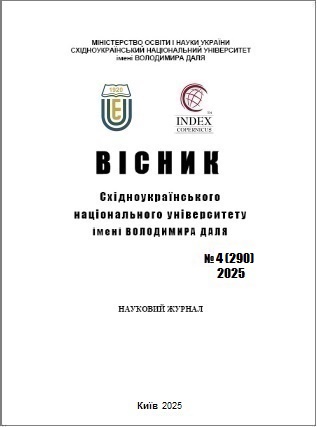Останні досягнення у створенні водних емульсій на основі полімеру полілактиду
DOI:
https://doi.org/10.33216/1998-7927-2025-290-4-63-71Ключові слова:
полі(молочна кислота), полімер, водні дисперсії, плівкоутворенняАнотація
Сучасна тенденція до екологічного та сталого розвитку спонукає дослідників і науковців все більше приділяти уваги вивченню та вдосконаленню потенційних біополімерів як альтернативи традиційним полімерним матеріалам. Хоча полімери на основі відновлюваної сировини вже широко застосовуються в медицині та пакуванні, вони все ще потребують подальших досліджень для досягнення характеристик, порівнянних із традиційними полімерними системами, з метою розширення сфер їх застосування. Емульсії на основі полі(молочної кислоти) (PLA) привертають значну увагу у лакофарбовій промисловості завдяки своїй біорозкладності, сталості та потенціалу заміни традиційних систем на основі розчинників і полімерів з викопної сировини. У цьому огляді представлено всебічний аналіз сучасних досліджень і досягнень у галузі підготовки емульсій PLA з акцентом на фундаментальні властивості емульсій та різні методи синтезу, зокрема випаровування розчинника, емульгування з дифузією та гомогенізацію під високим тиском. Проаналізовано роль стабілізаторів і розчинників у забезпеченні стабільності емульсій і їхнього впливу на кінцеві властивості покриттів. Окремо розглянуто широко вживані ПАР та біоосновні стабілізатори.
Попри численні переваги, емульсії PLA мають низку викликів, зокрема гідрофобність, фазове розшарування та обмежені механічні характеристики, що стримує їхнє широке промислове застосування. У цьому огляді ідентифіковано основні проблеми та розглянуто потенційні шляхи їх подолання, включаючи використання нанотехнологій, біоосновних стабілізаторів і оптимізованих технологій обробки. Також обговорюються стратегії покращення масштабованості, зменшення екологічного впливу емульсій PLA та перспективні напрями застосування. Оскільки наявні дослідницькі результати здебільшого представлені у вигляді окремих експериментальних робіт, цей огляд має на меті систематизувати накопичену інформацію у вигляді структурованого та порівняльного аналізу. Таким чином, він закладає підґрунтя для подальших досліджень і впроваджень у сфері екологічно безпечних покривних матеріалів.
Посилання
1. Ritchie H., Roser M. Plastic pollution / H. Ritchie, M. Roser // Our World in Data. 2018. https://ourworldindata.org/plastic-pollution.
2. Poly(Lactic acid) / ed. by R. Auras et al. Hoboken, NJ, USA : John Wiley & Sons, Inc., 2010. URL: https://doi.org/10.1002/9780470649848.
3. Farah S., Anderson D. G., Langer R. Physical and mechanical properties of PLA, and their functions in widespread applications – A comprehensive review. Advanced drug delivery reviews. 2016. Vol. 107. P. 367–392. URL: https://doi.org/10.1016/j.addr.2016.06.012.
4. Recent advances in biodegradable polymers for sustainable applications / A. Samir et al. Npj materials degradation. 2022. Vol. 6, no. 1. P. 1–28. URL: https://doi.org/10.1038/s41529-022-00277-7.
5. Plastics of the future? The impact of biodegradable polymers on the environment and on society / T. P. Haider et al. Angewandte chemie international edition. 2019. Vol. 58, no. 1. P. 50–62. URL: https://doi.org/10.1002/anie.201805766.
6. Bararnia H. Synthesizing emulsions via condensation : PhD thesis in Mechanical Engineering / H. Bararnia. University of Illinois at Chicago, 2021. 221 p., URL:https://indigo.uic.edu/ articles/thesis/Synthesizing_Emulsions_via_Condensation/15270372/1/files/29252910.pdf
7. Rheological response of polylactic acid dispersions in water with xanthan gum / S. Buoso et al. ACS omega. 2022. Vol. 7, no. 15. P. 12536–12548. URL: https://doi.org/10.1021/acsomega.1c05382.
8. Uniform-sized PLA nanoparticles: preparation by premix membrane emulsification / Q. Wei et al. International journal of pharmaceutics. 2008. Vol. 359, no. 1-2. P. 294–297. URL: https://doi.org/10.1016/j.ijpharm.2008.03.027
9. Shetgaonkar G. G., Kumar L. Ultrasound-Activated nanoparticles. Emerging technologies for nanoparticle manufacturing / ed. by J. K. Patel, Y. V. Pathak. Cham, 2021. P. 301–332. URL: https://doi.org/10.1007/978-3-030-50703-9_13.
10. Preparation of nanoemulsions by high-energy and lowenergy emulsification methods / H. Jasmina et al. Cmbebih 2017 / ed. by A. Badnjevic. Singapore, 2017. Vol. 62. P. 317–322. URL: https://doi.org/10.1007/978-981-10-4166-2_48.
11. Mcclements D. J. Critical review of techniques and methodologies for characterization of emulsion stability. Critical reviews in food science and nutrition. 2007. Vol. 47, no. 7. P. 611–649. URL: https://doi.org/10.1080/10408390701289292.
12. Emulsions and emulsifiers / K. Sarathchandraprakash et al., Asian J. Exp. Chem., vol. 8, no. 1&2, pp. 30-45, 2013.
13. Influence of stabilizing agents and preparative variables on the formation of poly(d,l-lactic acid) nanoparticles by an emulsification-diffusion technique / D. Quintanar-Guerrero et al. International journal of pharmaceutics. 1996. Vol. 143, no. 2. P. 133–141. URL: https://doi.org/10.1016/s0378-5173(96)04697-2.
14. Interfacial and thermodynamic approach of surfactants with α-chymotrypsin and trypsin: a comparative study / R. Banjare at el., Indian journal of chemistry section a. 2020.
15. Sizing down and functionalizing polylactide (PLA) resin for synthesis of PLA-based polyurethanes for use in biomedical applications / B. Nim et al. Scientific reports. 2023. Vol. 13, no. 1. P. 2284. URL: https://doi.org/10.1038/s41598-023-29496-x.
16. Preparations of poly(lactic acid) dispersions in water for coating applications / G. Belletti et al. Polymers. 2021. Vol. 13, no. 16. P. 2767. URL: https://doi.org/10.3390/polym13162767.
17. Astete C., Sabliov C. Synthesis and characterization of PLGA nanoparticles. Journal of biomaterials science. Polymer edition. 2006. Vol. 17. P. 247–89. URL:https://doi.org/10.1163/156856206775997322
18. Jem K. J., Tan B. The development and challenges of poly (lactic acid) and poly (glycolic acid). Advanced industrial and engineering polymer research. 2020. Vol. 3, no. 2. P. 60–70. URL: https://doi.org/10.1016/j.aiepr.2020.01.002
19. The development of poly(lactic acid) (pla)-based blends and modification strategies: methods of improving key properties towards technical applications–review / J. Andrzejewski et al. Materials. 2024. Vol. 17, no. 18. P. 4556. URL: https://doi.org/10.3390/ma17184556.
20. Lassalle V., Ferreira M. L. PLA nano‐ and microparticles for drug delivery: an overview of the methods of preparation. Macromolecular bioscience. 2007. Vol. 7, no. 6. P. 767–783. URL: https://doi.org/10.1002/mabi.200700022
21. Biswal T. Recent progress in PLA‐based composite and their application to biomedical and cosmetic fields. Biopolymers in pharmaceutical and food applications / ed. by S. Jana. 2024. P. 497–530. URL: https://doi.org/10.1002/9783527848133.ch23
22. Recent advances in the investigation of poly(lactic acid) (PLA) nanocomposites: incorporation of various nanofillers and their properties and applications / N. D. Bikiaris et al. Polymers. 2023. Vol. 15, no. 5. P. 1196. URL: https://doi.org/10.3390/polym15051196.
23. Preparation of high-solid PLA waterborne dispersions with PEG-PLA-PEG block copolymer as surfactant and their use as hydrophobic coating on paper / M. Calosi et al. Progress in organic coatings. 2024. Vol. 193. P. 108541. URL: https://doi.org/10.1016/j.porgcoat.2024.108541.
24. Enhancing polylactic acid (PLA) performance: A review of additives in fused deposition modelling (FDM) filaments / I. Plamadiala et al. Polymers. 2025. Vol. 17, no. 2. P. 191. URL: https://doi.org/10.3390/polym17020191.

